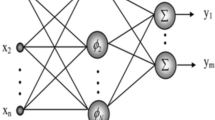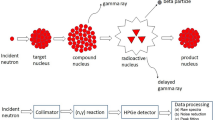Abstract
In this paper, three individual models and one generalized radial basis function neural network (RBFNN) model were developed for the prediction of the activity concentrations of primordial radionuclides, namely, 232Th, 238U and 40K. To achieve this, gamma spectrometry measurements of 126 different geological materials were used in the development of the RBFNN models. The results indicated that individual and generalized RBFNN models are quite efficient in predicting the activity concentrations of 232Th, 238U and 40K of geological materials.







Similar content being viewed by others
References
UNSCEAR (2000) Sources and effects of ionizing radiation. United Nations, New York
Hofstadter R (1949) The detection of gamma-rays with thallium-activated sodium iodide crystals. Phys Rev 75:796–810
Pilakouta M, Pappa FK, Patiris DL, Tsabaris C, Kalfas CA (2018) A methodology for expanding the use of NaI(Tl) based spectrometry in environmental radioactivity measurements. Appl Radiat Isot 139:159–168
Eker GBC, Çağlar İ (2019) A study on calculation of full energy peak efficiency of NaI(Tl) detectors using point source. Cauc J Sci 6(1):28–36
Sahin L, Cavas M (2008) Natural radioactivity measurements in soil samples of Central Kutahya (Turkey). Radiat Prot Dosim 131:526–530
Tabar E, Yakut H, Saç MM, Taşköprü C, İchedef M, Kuş A (2017) Natural radioactivity levels and related risk assessment in soil samples from Sakarya, Turkey. J Radioanal Nucl Chem. https://doi.org/10.1007/s10967-017-5266-2
Shilpa GM, Anandaram BN, Mohankumari TL (2018) Measurement of activity concentration of primordial radionuclides in soil samples from Thirthahalli Taluk and the assessment of resulting radiation dose. J Radioanal Nucl Chem 316:501–511
Al-Ghamdi A (2019) Health risk assessment of natural background radiation in the soil of Eastern Province, Saudi Arabia. J Radiat Res Appl Sci 12:219–225
Bajoga A, Al-Dabbous A, Abdullahi A, Alazemi N, Bachama Y, Alaswad S (2019) Evaluation of elemental concentrations of uranium, thorium and potassium in top soils from Kuwait. Nucl Eng Technol 51(6):1636–2164
Filgueiras RA, Silva AX, Ribeiro FCA, Lauria DC, Viglio EP (2019) Baseline, mapping and dose estimation of natural radioactivity in soils of the Brazilian state of Alagoas. Radiat Phys Chem 167:108332–108338
Akbar A, Asley K, Şeref T, Fatemeh M (2020) Radiation hazards and natural radioactivity levels in surface soil samples from dwelling areas of North Cyprus. J Radioanal Nucl Chem 324:203–210
Somsavath L, Giang TTP, Thang DD, Le N-T, Khong NK, Sounthone S, Hai-Nam T, Van LB (2020) Natural radioactivity measurement and radiological hazard evaluation in surface soils in a gold mining area and surrounding regions in Bolikhamxay Province, Laos. J Radioanal Nucl Chem 326:997–1007
Srinivasa E, Rangaswamy DR, Suresh SN, Sannappa J (2022) Natural radioactivity levels and associated radiation hazards in soil samples of Chikkamagaluru District, Karnataka, India. J Radioanal Nucl Chem 331:1899–1906
Roshani GH, Karami A, Salehizadeh A, Nazemi E (2017) The capability of radial basis function to forecast the volume fractions of the annular three-phase flow of gas–oil–water. Appl Radiat Isot 129:156–162
Buhmann MD (2003) Radial basis functions: theory and implementations. Cambridge University Press, Cambridge
Zadeh EE, Feghhi SAH, Roshani GH, Rezaei A (2016) Application of artificial neural network in precise prediction of cement elements percentages based on the neutron activation analysis. Eur Phys J Plus 131:167
Alvar AA, Deevband MR, Ashtiyani M (2017) Neutron spectrum unfolding using radial basis function neural networks. Appl Radiat Isot 129:35–41
Moody J, Darken CJ (1989) Fast learning in networks of locally-tuned processing units. Neural Comput 1(2):281–294
Park J, Sandberg IW (1991) Universal approximation using radial basis-function networks”. Neural Comput 3(2):246–257
Zayandehroodi H, Mohamed A, Shareef H, Mohammadjafari M (2010) Automated fault location in a power system with distributed generations using radial basis function neural networks. J Appl Sci 10:3032–3041
Erzin S (2019) Application of artificial neural networks to gamma spectrometric measurements. PhD Thesis, Ege University, İzmir (Turkish with English abstract)
Broomhead D, Lowe D (1988) Multivariable functional interpolation and adaptive networks. Complex Syst 2:321–355
Ham F, Kostanic I (2001) Principles of neurocomputing for science and engineering. McGraw-Hill, New York
Segal R, Kothari ML, Madnani S (2000) Radial basis function (RBF) network adaptive power system stabilizer. IEEE Trans Power Syst 15:722–727
Szczurek A, Maciejewska M (2004) Recognition of benzene, toluene and xylene using TGS array integrated with linear and non-linear classifier. Talanta 64:609–617
Haykin S (2009) Neural networks and learning machines, vol 3. Pearson, Upper Saddle River
Yaprak G (1995) Matrix effects on gamma spectrometric analysis of radioactive materials and development a self absorption correction method. PhD Thesis, Ege University, İzmir (Turkish with English abstract)
Yaprak G, Aslani MAA (2010) External dose-rates for natural gamma emitters in soils from an agricultural land in West Anatolia. J Radioanal Nucl Chem 283:279–287
Bors AG, Pitas I (1996) Median radial basis function neural network. IEEE Trans Neural Netw 7:1351–1364
Snedecor GW, Cochran WG (1989) Statistical methods, 8th edn. Iowa State University Press, Ames
Gupta AK (2010) Predictive modelling of turning operations using response surface methodology, artificial neural networks and support vector regression. Int J Prod Res 48:763–778
Acknowledgements
The authors are grateful Dr. Zsolt Revay, Editor-in-Chief of Journal of Radioanalytical and Nuclear Chemistry, and two anonymous reviewers for their constructive criticism leading to extensive improvement in the revised manuscript.
Author information
Authors and Affiliations
Corresponding author
Ethics declarations
Conflict of interest
The authors declare that there is no conflict of interest regarding the publication of this paper.
Additional information
Publisher's Note
Springer Nature remains neutral with regard to jurisdictional claims in published maps and institutional affiliations.
Rights and permissions
About this article
Cite this article
Erzin, S., Yaprak, G. Prediction of the activity concentrations of 232Th, 238U and 40K in geological materials using radial basis function neural network. J Radioanal Nucl Chem 331, 3525–3533 (2022). https://doi.org/10.1007/s10967-022-08438-3
Received:
Accepted:
Published:
Issue Date:
DOI: https://doi.org/10.1007/s10967-022-08438-3




